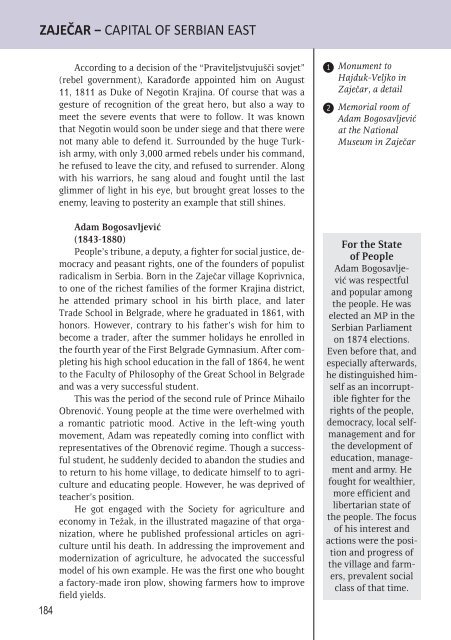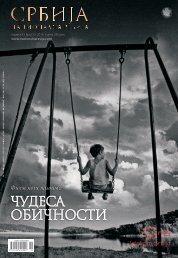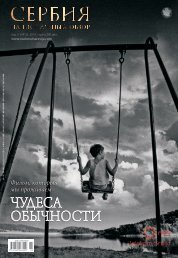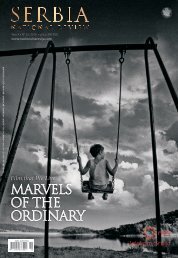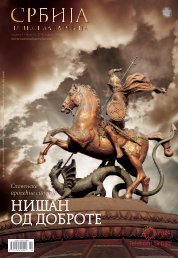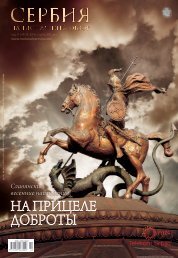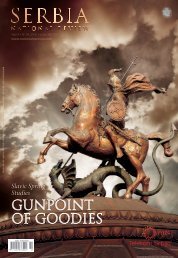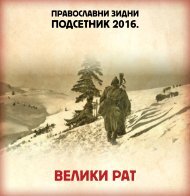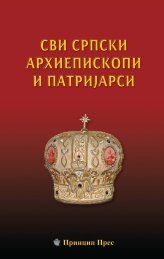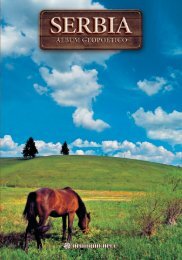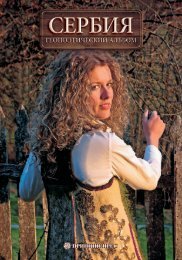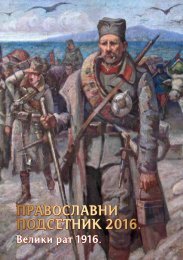Zajecar - engleski - niska rezolucija
You also want an ePaper? Increase the reach of your titles
YUMPU automatically turns print PDFs into web optimized ePapers that Google loves.
ZAJEČAR − CAPITAL OF SERBIAN EAST<br />
According to a decision of the “Praviteljstvujušči sovjet”<br />
(rebel government), Karađorđe appointed him on August<br />
11, 1811 as Duke of Negotin Krajina. Of course that was a<br />
gesture of recognition of the great hero, but also a way to<br />
meet the severe events that were to follow. It was known<br />
that Negotin would soon be under siege and that there were<br />
not many able to defend it. Surrounded by the huge Turkish<br />
army, with only 3,000 armed rebels under his command,<br />
he refused to leave the city, and refused to surrender. Along<br />
with his warriors, he sang aloud and fought until the last<br />
glimmer of light in his eye, but brought great losses to the<br />
enemy, leaving to posterity an example that still shines.<br />
1<br />
2<br />
Monument to<br />
Haj duk-Velj ko in<br />
Zaječar, a detail<br />
Memorial room of<br />
Ada m Bo go sa vlje vi ć<br />
at the National<br />
Museum in Za je ča r<br />
Adam Bogosavljević<br />
(1843-1880)<br />
People’s tribune, a deputy, a fighter for social justice, democracy<br />
and peasant rights, one of the founders of populist<br />
radicalism in Serbia. Born in the Zaječar village Koprivnica,<br />
to one of the richest families of the former Krajina district,<br />
he attended primary school in his birth place, and later<br />
Trade School in Belgrade, where he graduated in 1861, with<br />
honors. However, contrary to his father’s wish for him to<br />
become a trader, after the summer holidays he enrolled in<br />
the fourth year of the First Belgrade Gymnasium. After completing<br />
his high school education in the fall of 1864, he went<br />
to the Faculty of Philosophy of the Great School in Belgrade<br />
and was a very successful student.<br />
This was the period of the second rule of Prince Mihailo<br />
Obrenović. Young people at the time were overhelmed with<br />
a romantic patriotic mood. Active in the left-wing youth<br />
movement, Adam was repeatedly coming into conflict with<br />
representatives of the Obrenović regime. Though a successful<br />
student, he suddenly decided to abandon the studies and<br />
to return to his home village, to dedicate himself to to agriculture<br />
and educating people. However, he was deprived of<br />
teacher’s position.<br />
He got engaged with the Society for agriculture and<br />
economy in Težak, in the illustrated magazine of that organization,<br />
where he published professional articles on agriculture<br />
until his death. In addressing the improvement and<br />
modernization of agriculture, he advocated the successful<br />
model of his own example. He was the first one who bought<br />
a factory-made iron plow, showing farmers how to improve<br />
field yields.<br />
184<br />
For the State<br />
of People<br />
Adam Bo go sa vljević<br />
was respectful<br />
and popular among<br />
the people. He was<br />
elected an MP in the<br />
Serbian Parliament<br />
on 1874 elections.<br />
Even before that, and<br />
especially afterwards,<br />
he distinguished himself<br />
as an incorruptible<br />
fighter for the<br />
rights of the people,<br />
democracy, local selfmanagement<br />
and for<br />
the development of<br />
education, management<br />
and army. He<br />
fought for wealthier,<br />
more efficient and<br />
libertarian state of<br />
the people. The focus<br />
of his interest and<br />
actions were the position<br />
and progress of<br />
the village and farmers,<br />
prevalent social<br />
class of that time.


